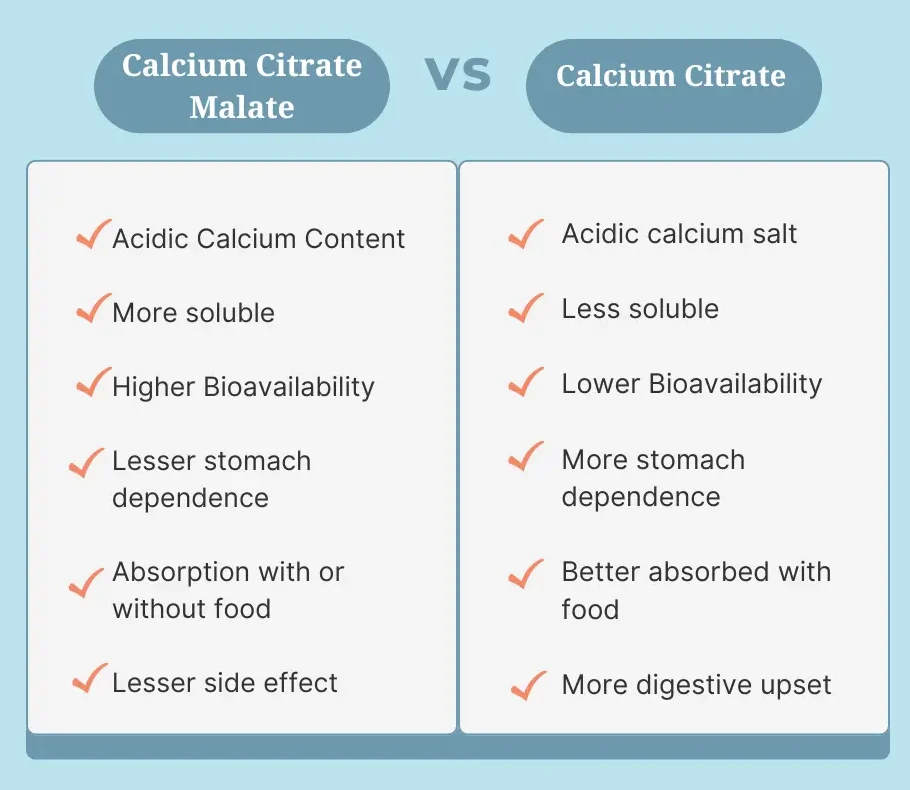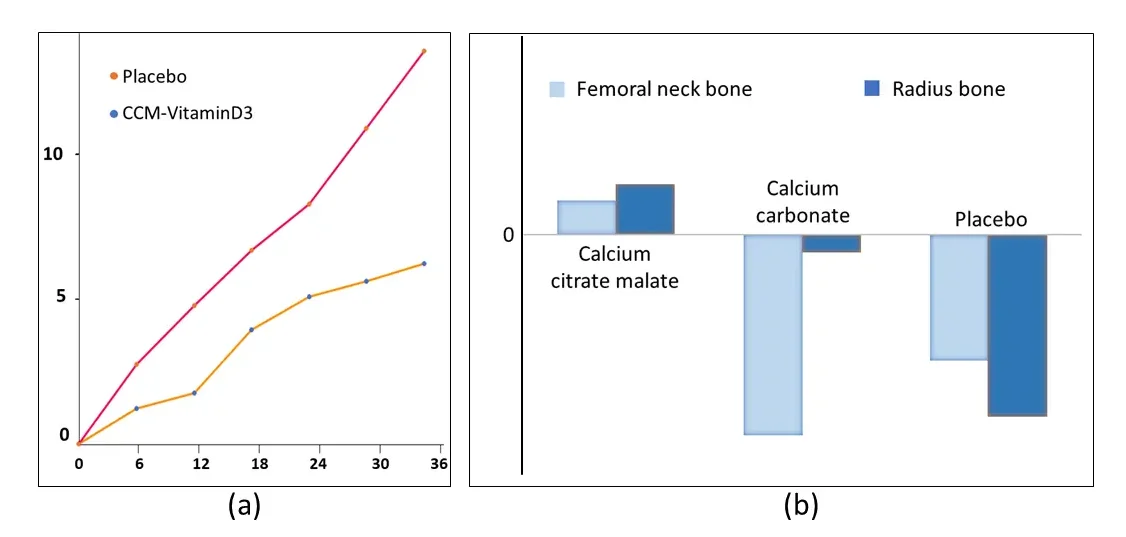Citrate vs. Citrate Malate – The Ultimate Showdown for Bone Strength
When it comes to bone health, calcium is the undisputed heavyweight champ. But within this realm lies a battle royal – a fight for supremacy between two common calcium supplement contenders1: calcium citrate and calcium citrate malate. Both boast impressive credentials, but only one can truly claim the title of the ultimate bone builder. Let’s delve into the ring, analyse their strengths and weaknesses, and ultimately crown the victor!345
| Ca salt | Chemical formula | Molecular weight (g/mol) | % Ca (elemental Ca) |
| Calcium citrate | Ca3(C6H5O7) | 498.44 | 24.12 |
| Calcium citrate malate | Ca3(C6H5O7) | 1014.9 | 23.7 |
Calcium Citrate: The Reliable Veteran
Calcium citrate has been a mainstay in the calcium supplement arena for decades5. This popular form is known for its high bioavailability, meaning your body readily absorbs the calcium it contains6. This is a significant advantage, especially for individuals with low stomach acid78. Unlike some other calcium supplements, calcium citrate doesn’t require a highly acidic environment for absorption, making it a stomach-friendly choice9.
Citrate’s popularity isn’t just about convenience – it offers several key benefits:
- Gentle on the Gut: Many calcium supplements, like calcium carbonate, can cause constipation. Calcium citrate, on the other hand, is generally well-tolerated and less likely to disrupt your digestive system10.
- Widely Available: Finding calcium citrate is a breeze. It’s a staple in most drugstores and health food stores, making it a readily accessible option.
- Proven Track Record: Years of research and clinical use have established calcium citrate as an effective way to increase calcium intake and support bone health11.
However, even the most seasoned veteran has room for improvement. While calcium citrate is a dependable choice, recent research suggests a challenger might offer a slight edge: calcium citrate malate.

Calcium Citrate Malate: The Innovative Challenger
This newcomer takes the familiar calcium citrate formula and adds a twist – malic acid. Malic acid, naturally found in fruits like apples, might be the secret weapon that elevates calcium citrate malate’s function12. Leafy green vegetables are a great source of calcium citrate malate. Calcium citrate malate powder typically appears as a white to off-white powder or fine granules. This powdery consistency allows it to be easily encapsulated in supplements or mixed into drinks13. Unlike some other calcium supplements, it boasts good solubility in water, meaning it dissolves readily for efficient absorption within the body.
Here’s where calcium citrate malate steps into the ring, potentially delivering some knockout punches:
Enhanced Absorption:
Studies suggest calcium citrate malate offers better absorption compared to plain calcium citrate1415, particularly for those with low vitamin D. This translates to more readily available calcium for your body.
One gram of calcium citrate malate USP typically provides around 200mg of elemental calcium in calcium citrate malate, the standard measurement for calcium content. The inclusion of malic acid in calcium citrate malate benefits, with its additional carboxylic acid group, might be the secret weapon.
This potentially enhances the overall calcium citrate malate solubility, making it easier to dissolve and absorb, especially for individuals with digestive issues16.
This improved solubility also translates to its high mixability in drinks and easy absorption, maximizing its bone-building potential. Calcium citrate malate supplements come in various convenient forms like capsules, tablets, and even powders for easy mixing into beverages.
Bone Health Potential:
Bone woes got you down? Here’s where calcium citrate malate (CCM) comes in as a knight in shining armour for your skeletal system17.
Unlike other calcium sources that need to be paired with food for absorption, CCM is a superhero that works anytime, with or without a meal. This translates to better bone health for adults, especially postmenopausal women.
Studies suggest not only calcium citrate malate for bone loss slowing down in older adults but also calcium citrate malate for healing fractures18. Bonus: for those prone to kidney stones, CCM won’t worsen the problem!
Early research showed calcium citrate malate might be more effective than placebo or even calcium carbonate in boosting bone health for postmenopausal women with low calcium intake (Fig -2a).
While more studies are needed to solidify this claim, the initial findings are promising for those seeking a supplement that goes beyond just maintaining bone health1920.
Based on the evidence, calcium citrate malate appears to be the superior choice for most individuals seeking optimal bone health21.

Calcium citrate malate uses
For bone health champions, calcium citrate malate (CCM) and vitamin D3 are a powerful duo. CCM, unlike some calcium sources, is easily absorbed by your body, even without food. Vitamin D3, often called the sunshine vitamin, is crucial for helping your body use that calcium.
Together, they work to strengthen bones and reduce the risk of fractures, especially important as we age. It has been seen in study that over three years, 5.9% of people in the calcium citrate malate + vitamin D3, and folic acid group suffered a first-time fracture, compared to 12.9% in the placebo group (Fig – 2b)22.

For those concerned about bone health, calcium citrate malate (CCM), calcitriol, and vitamin K2-7 form a dream team of nutrients. CCM provides readily absorbed calcium, the building block of strong bones.
Calcitriol, the active form of vitamin D, acts like a supercharger, helping your body absorb even more calcium from your gut23. Vitamin K2-7 then steps in like a conductor, directing that calcium to your bones and teeth where it’s most needed. This powerful trio can help prevent bone fractures24.
- Calcium is vital for both mom and baby during pregnancy, with enough supporting the development of strong bones and teeth for your little one. Calcium citrate malate in pregnancy is widely used for being easily absorbed by the body25.
- While research on the effects of calcium citrate malate for sperm is ongoing, some studies suggest it may play a role in male fertility.
- While calcium citrate malate is primarily researched for its bone health benefits, some early studies are exploring calcium citrate malate benefits for skin health.
- While some kids get enough calcium from their diet, calcium citrate malate for kids can be an option for children with low calcium intake to support healthy bone development.
Conclusion
When it comes to choosing a calcium supplement, both calcium citrate and calcium citrate malate (CCM) are good options. However, CCM might be the champion for a few reasons. Cost-wise, calcium citrate tends to be slightly cheaper.
But, that small price difference can be offset by the potential for needing a higher dose of calcium citrate because it isn’t absorbed quite as well as CCM26.
Here’s the kicker: calcium citrate can sometimes cause side effects like constipation and bloating, while CCM is gentler on the digestive system. So, while calcium citrate might be a budget-friendly option initially, CCM’s superior absorption and milder side effects might make it the more cost-effective choice in the long run.
-
Apgar, Comparison of Common Calcium Supplements, Am Fam Physician. 2000;62(8):1895-1896, https://www.aafp.org/pubs/afp/issues/2000/1015/p1895.html
-
Gour, G. Understanding different types of calcium supplements, Jun 1, 2022. https://www.guardian.in/blogs/livewell/understanding-different-types-of-calcium-supplements
-
Reinwald S, Weaver CM, Kester JJ. The health benefits of calcium citrate malate: a review of the supporting science. Adv Food Nutr Res. 2008;54:219-346. doi: 10.1016/S1043-4526(07)00006-X. PMID: 18291308. https://pubmed.ncbi.nlm.nih.gov/18291308/
-
Mumtaz et al., Clinical Applications and Properties of Calcium Citrate Malate, Int. J. Pharm. Sci. Rev. Res., 69(1), July – August 2021; Article No. 09, Pages: 51-67, https://globalresearchonline.net/journalcontents/v69-1/09.pdf
-
Tolentino, K., What Are the Different Types of Calcium? Verywellhealth. https://www.verywellhealth.com/what-kind-of-calcium-to-buy-3522296
-
National Center for Biotechnology Information. PubChem Compound Summary for CID 13136, Calcium citrate. https://pubchem.ncbi.nlm.nih.gov/compound/Calcium-citrate.
-
Amy B. Gragnolati, PharmD, BCPS, Calcium Carbonate vs. Calcium Citrate: 4 Differences Between These Common Calcium Supplements, GoodRxHealth. https://www.goodrx.com/calcium-carbonate/calcium-carbonate-vs-calcium-citrate
-
Saljoughian, M., Pros and Cons of Calcium Supplements, US Pharm. 2015;40(9):HS-28-HS-32. https://www.uspharmacist.com/article/pros-and-cons-of-calcium-supplements
-
Wikipedia contributors. Calcium citrate. Wikipedia, The Free Encyclopedia. January 24, 2024, 13:08 UTC. Available at: https://en.wikipedia.org/w/index.php?title=Calcium_citrate&oldid=1198571632.
-
Xu, Y., Ye, J., Zhou, D. et al.Research progress on applications of calcium derived from marine organisms. Sci Rep 10, 18425 (2020). https://doi.org/10.1038/s41598-020-75575-8
-
Yuan Jingcheng Yuan Qun (1999) Process for preparing calcium citrate malate by using citric acid, malic acid and calcium carbonate, Chinese Patent No. CN1257062A, China https://patents.google.com/patent/CN1257062A/en
-
Wikipedia contributors. Calcium citrate malate. Wikipedia, The Free Encyclopedia. January 2, 2021, 21:27 UTC. Available at: https://en.wikipedia.org/w/index.php?title=Calcium_citrate_malate&oldid=997914363.
-
Reinwald S, Weaver CM, Kester JJ. The health benefits of calcium citrate malate: a review of the supporting science. Adv Food Nutr Res. 2008;54:219-346. doi: 10.1016/S1043-4526(07)00006-X. PMID: 18291308.
-
Tobback, P. (2007). Calcium citrate malate as source for calcium for use in foods for Particular Nutritional Uses and in foods for the general population ( including food supplements ). https://www.semanticscholar.org/paper/Calcium-citrate-malate-as-source-for-calcium-for-in-Tobback/8bf9ad05d231112c853b80799272d99bbed63ee6
-
Rzymski, P., Pischel, I., Conrad, F. et al.The bioavailability of calcium in the form of pyruvate, carbonate, citrate–malate in healthy postmenopausal women. Eur Food Res Technol 242, 45–50 (2016). https://doi.org/10.1007/s00217-015-2516-9
-
Kochanowski BA. Effect of calcium citrate-malate on skeletal development in young, growing rats. J Nutr. 1990 Aug;120(8):876-81. doi: 10.1093/jn/120.8.876. PMID: 2380795. https://pubmed.ncbi.nlm.nih.gov/2380795/
-
Patrick L. Comparative absorption of calcium sources and calcium citrate malate for the prevention of osteoporosis. Altern Med Rev. 1999 Apr;4(2):74-85. PMID: 10231607. https://pubmed.ncbi.nlm.nih.gov/10231607/
-
Toldra et., Calcium citrate malate as source for calcium for use in foods for Particular Nutritional Uses and in foods for the general population (including food supplements), The EFSA Journal (2007) 612, 1-24. https://efsa.onlinelibrary.wiley.com/doi/pdf/10.2903/j.efsa.2007.612
-
Melissa J. Benton & Andrea White. (2006) Osteoporosis: Recommendations for Resistance Exercise and Supplementation With Calcium and Vitamin D to Promote Bone Health. Journal of Community Health Nursing23:4, pages 201-211. https://www.tandfonline.com/doi/citedby/10.1080/07315724.1996.10718604?scroll=top&needAccess=true
-
Long Tan, Ruiqian He, iXiaoxue Zheng, Effect of vitamin D, calcium, or combined supplementation on fall prevention: a systematic review and updated network meta-analysis, BMC Geriatrics, 24, 1, (2024).https://doi.org/10.1186/s12877-024-05009-x
-
Scientific Opinion of the Panel on Food additives, Flavourings, Processing aids and Materials in Contact with food (AFC) on a request from the Commission on Calcium citrate malate as source for calcium intended for use in foods for Particular Nutritional Uses (PARNUTS) and in foods for the general population (including food supplements). The EFSA Journal(2007) 612, 1–24. https://efsa.onlinelibrary.wiley.com/action/showCitFormats?doi=10.2903%2Fj.efsa.2007.612
-
Reinwald, Susan & Weaver, Connie & Kester, Jeffrey. (2008). The Health Benefits of Calcium Citrate Malate: A Review of the Supporting Science. Advances in food and nutrition research. 54. 219-346. 10.1016/S1043-4526(07)00006-X. https://www.researchgate.net/publication/5561503_The_Health_Benefits_of_Calcium_Citrate_Malate_A_Review_of_the_Supporting_Science
Calcium citrate malate is made from CaCO₃ (calcium carbonate), C₆H₈O₇ (citric acid), and C₄H₆O₅ (malic acid).
Calcium citrate malate and vitamin D3 tablets are used to improve bone health by providing calcium and enhancing its absorption through vitamin D3.
Calcium citrate malate is generally better absorbed than calcium carbonate, making it more effective for calcium supplementation.
The best time to take calcium citrate malate is with meals to enhance absorption and reduce gastrointestinal discomfort.
Yes, calcium citrate malate is beneficial for bone health because it is a well-absorbed form of calcium, helping prevent or manage conditions like osteoporosis.
No, calcium citrate malate doesn’t cause constipation if takes correctly.
Calcium citrate malate contains 20–24% calcium by dry weight.
